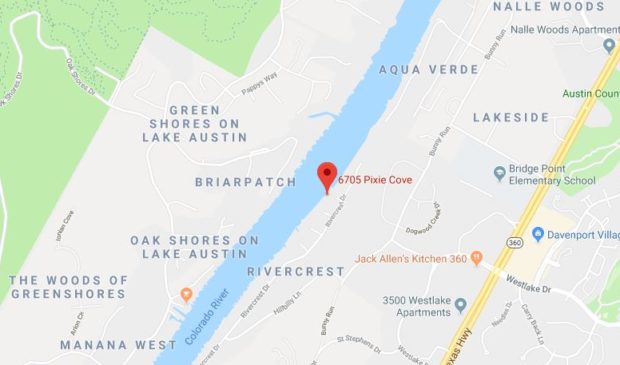Board of Adjustment determines the price of a view is a variance
Wednesday, June 13, 2018 by
Jessi Devenyns Given fierce opposition from a neighbor and unclear stories from an architect, a homeowner and an agent about how a home along the shores of Lake Austin was designed, 6705 Pixie Cove was once again shuffled back into the deck and postponed for another month.
After six months of postponements at the Board of Adjustment, Phillip Cameron, the homeowner, was asked to choose between forcing the board to vote at its June 11 meeting and risking a reconsideration at a later date if it failed, or postponing the decision for another month in hopes that he could provide further evidence to persuade the board to approve.
The variance request in question would permit him to rebuild on the original 1981 footprint of the home that was constructed before the Land Development Code altered the zoning to Lake Austin Residence (LA) zoning, which would allow for a shallower side yard and shoreline setback as well as maintaining a higher percentage of impervious cover on the property than what would be allowed under current code.
“I know it’s painful as hell,” said Board Member Michael Von Ohlen, “But I’m trying to look out for the applicant and the neighbor as well, and I don’t want you to have to do a reconsideration.”
The neighbor who vocally opposed this variance was Catherine Lewis, Cameron’s neighbor from across the canal. She said that she feared that Cameron would re-architect the boathouse that sits directly across from her backyard in a manner that would block her view across Lake Austin. In hopes of ensuring this would not be the case – she had no qualms about the boathouse remaining as it currently exists – she hired an attorney to request site plans, elevations and overlays for the project. She explained that she not only never received the documents but was never even given a response.
Terry Herring, Cameron’s attorney, said that he did have multiple conversations with Lewis’ attorney. However, he said that neither he nor his client was prepared to make guarantees about the boat slip in writing because legally they are entitled to an expansion.
David Cancialosi, who is representing the applicant on this case, said, “I fail to understand how the boat dock keeps coming up as an issue.” He insisted that advocating their boat rights has no bearing on the house design for which this variance is requested. Furthermore, he said, “we will not commit to a boat dock design if we cannot complete the house.”
“I think we’re just trying to get the total picture, and that boat dock is part of that property,” noted Board Member Brooke Bailey.
Van Ohlen said, “I’m cool with the same footprint and everything else, but I’d like to see elevations.” He noted that if elevation is within a foot or two of what is currently there, the new structure would not be a visual impediment to the Lewis household. However, Cancialosi was unable to provide elevations.
The project architect, Winn Wittman, displayed the rendering for the project, which showed the boat slip remained the same. He also noted that this project was keeping “50 to 75 percent of the exterior walls” and therefore is not technically new construction where modern variances are required to take effect.
At this revelation, board members expressed surprise. Bailey noted that now that the plans seemed to take a 180-degree turn, “there’s a lot of information we just don’t know.”
Van Ohlen explained that if the exterior walls are left standing and the footprint of the property remains the same, that paints a completely different picture for a variance consideration. “What needs to happen is y’all need to get your story straight,” he said. “When you scrape the lot, it’s a whole new ballgame.”
Chair William Burkhardt had a positive prediction for the applicant, provided that he and his team could provide a coherent plan with elevations and come to an agreement with the neighbor. “I think you’ll probably get this variance,” Burkhardt said. “See you next month.”
The Austin Monitor’s work is made possible by donations from the community. Though our reporting covers donors from time to time, we are careful to keep business and editorial efforts separate while maintaining transparency. A complete list of donors is available here, and our code of ethics is explained here.
You're a community leader
And we’re honored you look to us for serious, in-depth news. You know a strong community needs local and dedicated watchdog reporting. We’re here for you and that won’t change. Now will you take the powerful next step and support our nonprofit news organization?









